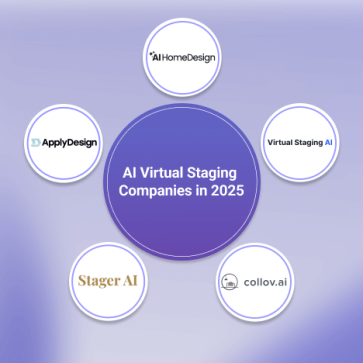Virtual staging typically costs between $30 and $150 per photo. AI-based platforms, however, start as low as $0.24 per photo, making them far cheaper than traditional staging. To learn more on such providers, read our guide to AI virtual staging.
For a typical listing with 30–35 photos, AI-based subscriptions can bring the total cost down to under $30, while designer-led services can exceed $2,500.
In this blog, we explore virtual staging costs and ROI in 2025.
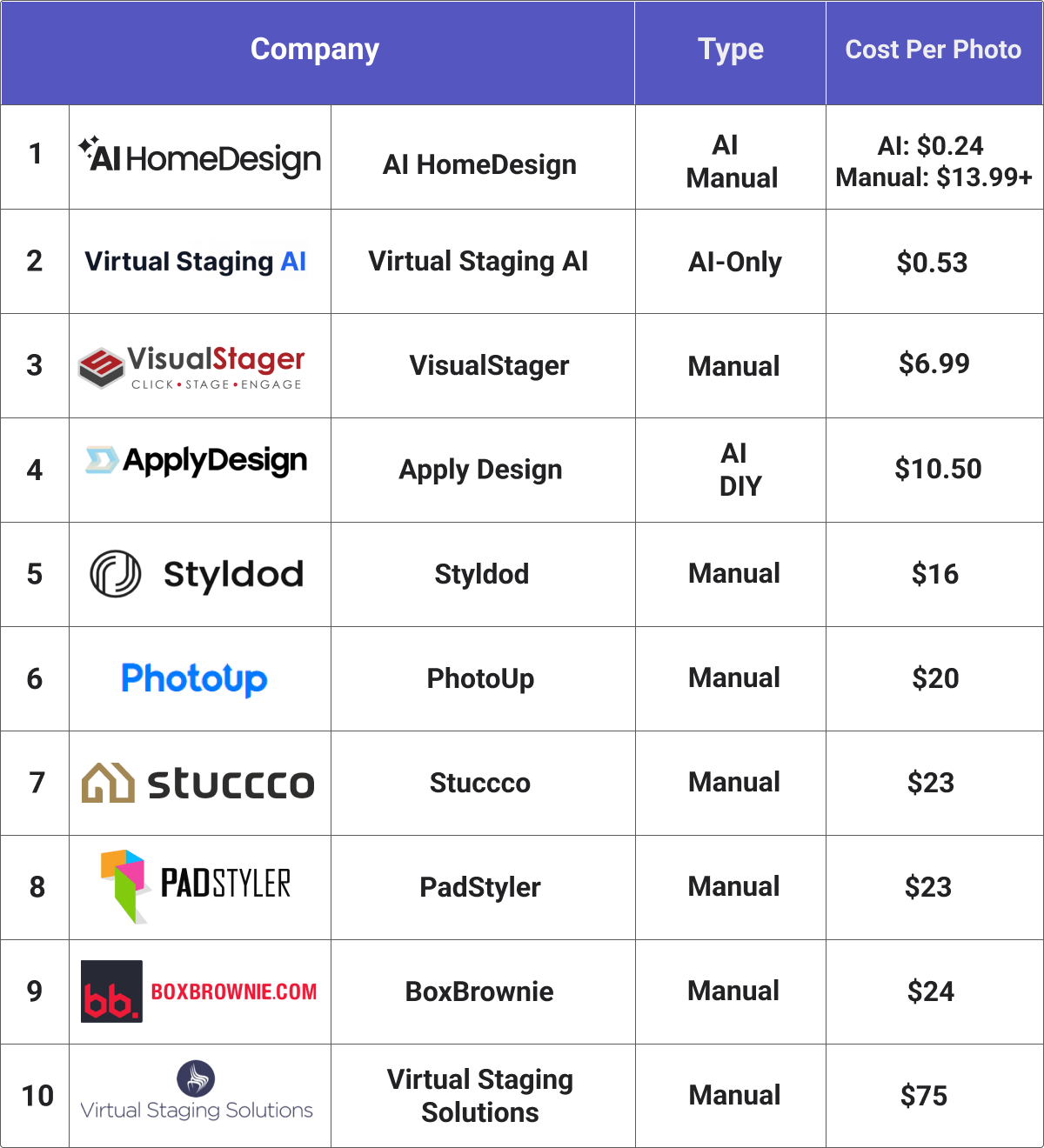
How Virtual Staging Cost Is Calculated
1. AI vs. Manual virtual staging
Virtual staging costs differ depending on the provider. Typically, AI-based services like AI HomeDesign, Virtual Staging AI, and Apply Design cost less, since their technology allows for faster results without heavy labor. On the other hand, companies like Box Brownie, Styldod, and PhotoUp that rely on professional designers often set higher prices, as each photo is handled manually with more time and detail involved.
2. Credit vs. per-photo pricing
Another thing you should know about virtual home staging costs is that some providers use a credit system instead of direct per-photo pricing. In these plans, you purchase credits in advance, often through monthly or yearly packages, and staging an image requires a set number of credits. For instance, a subscription might give you 30 credits per month, and one or more credits might be required to stage a photo.
3. Single vs. Multiple Edits
Another point to consider is how edits are priced. Some providers allow you to request several changes to the same photo under a single credit or fixed fee. Others, however, charge separately for each revision. This difference can make a big impact on overall costs, especially if you expect to fine-tune photos more than once.
Virtual staging cost by company
The table above summarizes the cost of virtual home staging by top virtual staging companies. Below, there is a more detailed description of each company’s pricing plans.
AI HomeDesign
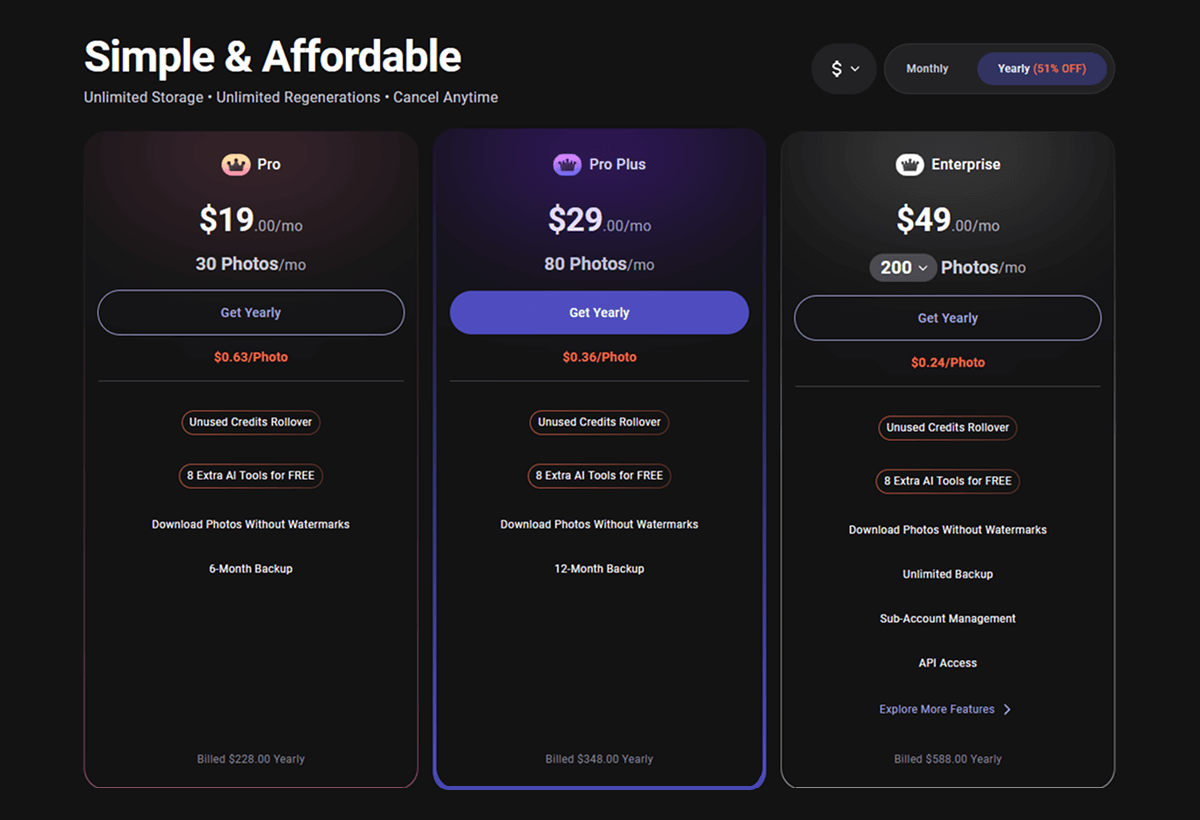
AI HomeDesign offers both manual and AI-driven virtual staging. For AI staging, there are three subscription tiers available, each with monthly and yearly options:
- Pro: $35/month for 30 photos, or $19/month (billed yearly) for 30 photos
- Pro plus: $59/month for 80 photos, or $29/month (billed yearly) for 80 photos
- Enterprise: $99/month for 200 photos, or $49/month (billed yearly) for 200 photos
- Manual virtual staging: $13.99 per photo
All AI-driven plans include unlimited renders and downloads, access to all room types and styles, furniture removal, no watermark, and a free image editing trial.

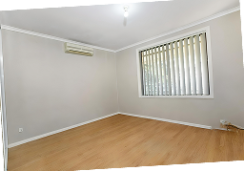
Virtual Staging AI
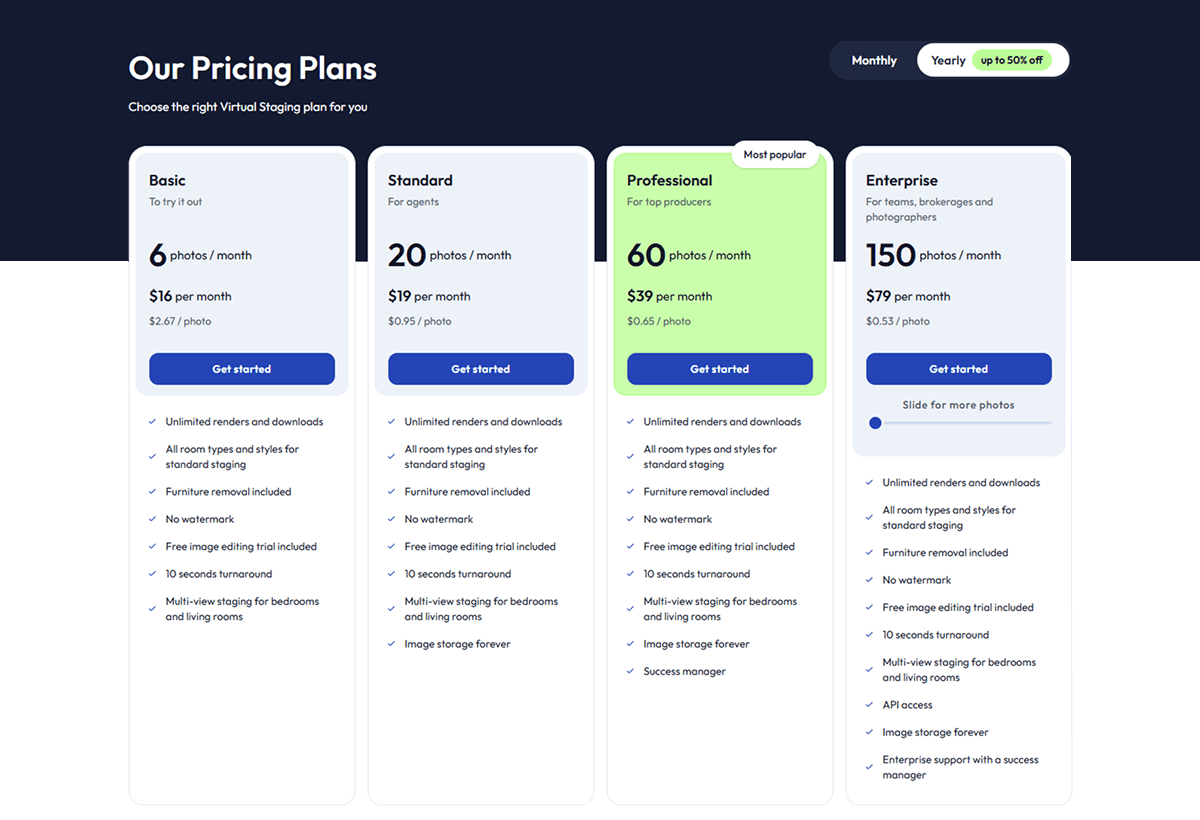
Virtual Staging AI offers four subscription tiers, available with both monthly and discounted yearly billing.
- Basic plan – $25/month for 6 photos ($4.17 per photo), or $16/month with yearly billing.
- Standard plan – $35/month for 20 photos ($1.75 per photo), or $19/month with yearly billing
- Professional plan – $79/month for 60 photos ($1.32 per photo), or $39/month with yearly billing
- Enterprise plan – $139/month for 150 photos ($0.93 per photo), or $79/month with yearly billing
VisualStager
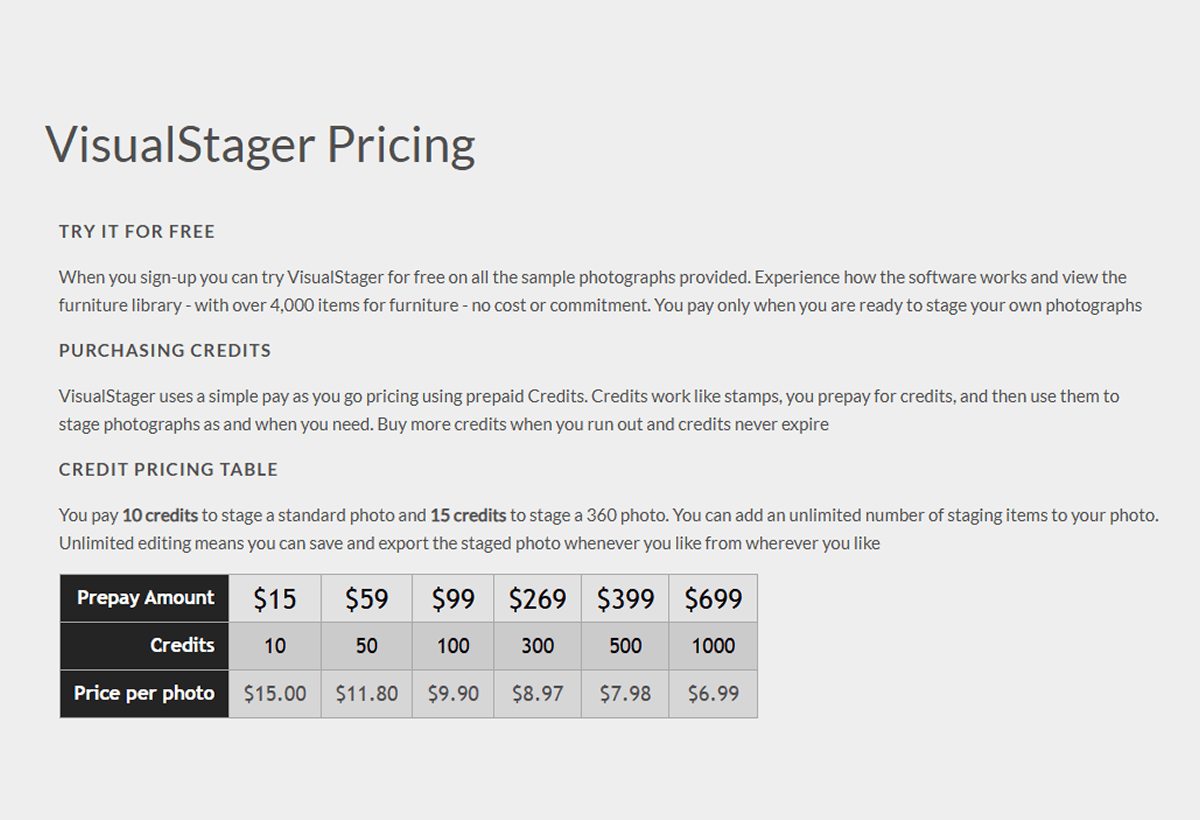
VisualStager uses a credit-based system rather than fixed monthly plans. Credits never expire, and you can buy them in bundles as needed.
- 10 credits cost $15 ($15.00 per photo)
- 50 credits cost $59 ($11.80 per photo)
- 100 credits cost $99 ($9.90 per photo)
- 300 credits cost $269 ($8.97 per photo)
- 500 credits cost $399 ($7.98 per photo)
- 1000 credits cost $699 ($6.99 per photo)
It takes 10 credits to stage a standard photo and 15 credits to stage a 360° photo. Once a photo is staged, you can edit it as many times as you want, add unlimited items from their furniture library, and download the results without additional cost.
Apply Design

Apply Design offers two models: Auto Staging and DIY Staging, both based on coins. The first image is free for new users.
- Coin pricing:
- $10/coin (up to 9 coins)
- $8/coin (10–19 coins)
- $7/coin (20+ coins)
- Auto staging:
- 2D photo – 1.5 coins ($10.50–$15/photo)
- 360° photo – 2.5 coins ($17.50–$25/photo)
- DIY staging:
- 2D photo – 1 coin ($7–$10/photo)
- 360° photo – 2 coins ($14–$20/photo)
Styldod

Styldod offers virtual staging services with per-image pricing.
- $16 per photo – for bulk orders of 8 or more images
- $23 per photo – for smaller orders (less than 8 images)
Turnaround time is typically 24–48 hours, with optional faster delivery.
- Rapid delivery: within 24 hours (+$6 per photo)
- Super rapid delivery: within 12 hours (+$12 per photo)
PhotoUp

PhotoUp offers both credit-based and subscription-based pricing for virtual staging and related services.
- Credit-based pricing:
- Virtual Staging – 20 credits per photo
- 360° Virtual Staging – 35 credits
- Credits start at about $1.10 each, with discounts for larger bundles.
- Monthly plans:
- Starter – $39/month, includes 50 credits, 5 property websites, 5 virtual tours, and 100GB storage
- Pro – $99/month, includes 130 credits, 50 websites, 50 tours, and 250GB storage
- Growth – $319/month, includes 400 credits, 500 websites, 500 tours, and 500GB storage
All plans include access to photo editing, unlimited revisions, and additional credits can be purchased as needed.
Stucco
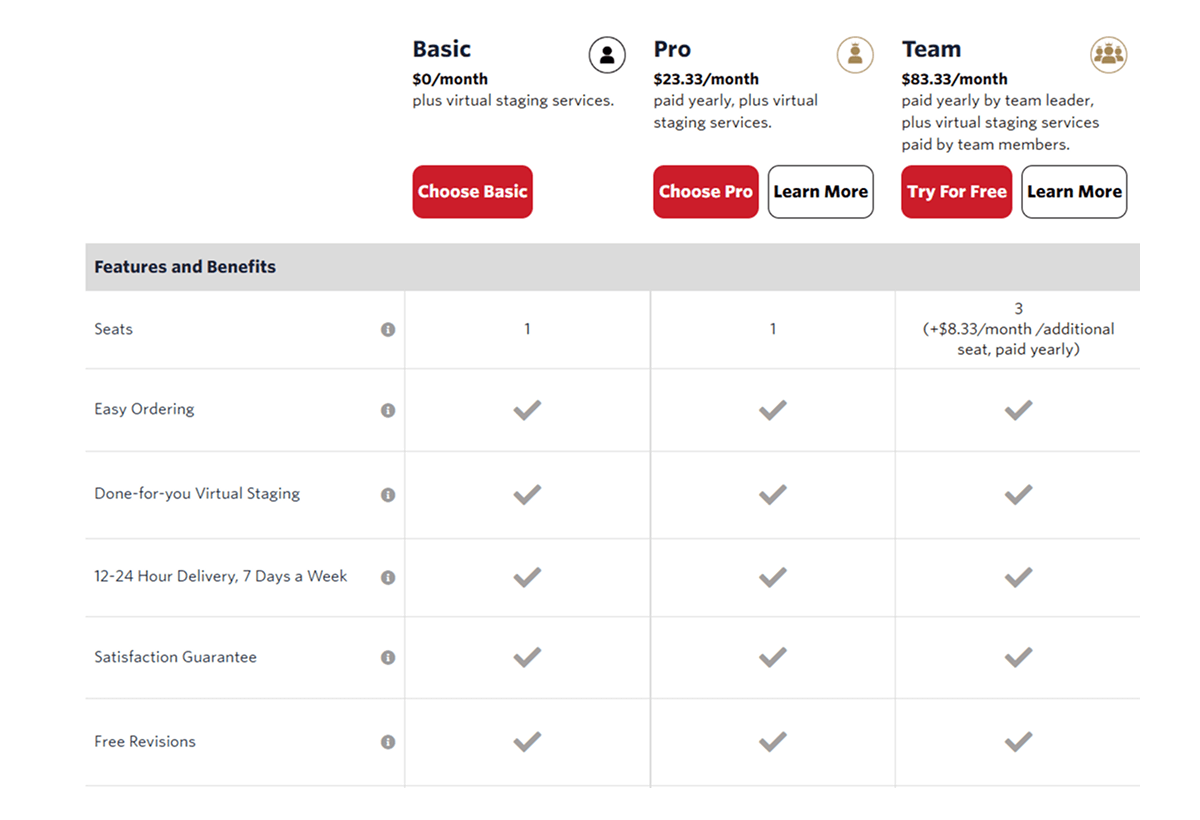
Stucco offers three subscription options for its virtual staging platform, available with either monthly or yearly billing.
- Basic – Free ($0/month), includes one seat and access to core staging services
- Pro – $39/month (or $23.33/month when billed yearly), includes one seat, done-for-you staging, 12–24 hour delivery, free revisions, and satisfaction guarantee
- Team – $100/month (or $83.33/month when billed yearly), includes three seats with the option to add extra seats ($10/month or $8.33/month yearly per seat).
All plans provide access to Stucco’s “done-for-you” virtual staging service, with turnaround in 12–24 hours, unlimited revisions, and a satisfaction guarantee.
PadStyler
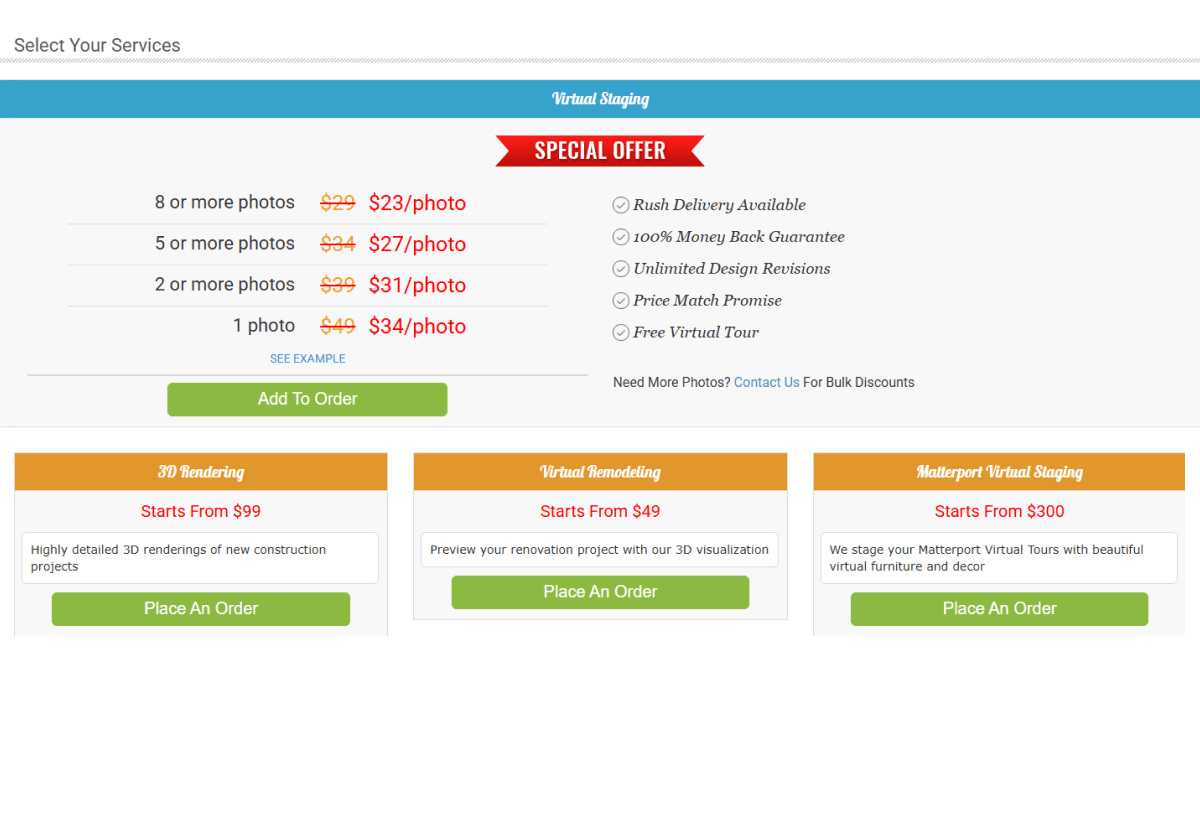
PadStyler offers per-image pricing for virtual staging, with discounts for larger orders.
- $23 per photo – for orders of 8 or more photos
- $27 per photo – for orders of 5–7 photos
- $31 per photo – for orders of 2–4 photos
- $34 per photo – for a single photo
Services include unlimited design revisions, a 100% money-back guarantee, a price match promise, and rush delivery options at an added cost.
BoxBrownie
BoxBrownie offers straightforward, per-image pricing for virtual staging, with optional add-ons for speed and customization.
- Virtual staging – $24 per photo
- 360° virtual staging – $48 per photo
Turnaround time is typically 48 hours, with optional expedited delivery available at an additional cost.
Virtual staging solutions
Virtual Staging Solutions offers a straightforward per-image pricing model.
- $75 per photo
What is the ROI of virtual staging?
Virtual staging ROI comes from two clear advantages. First, it reduces staging costs from thousands to just a few dollars per listing. For example, with AI HomeDesign, you can stage 30 photos for only $19, which is a considerable saving compared with traditional staging.
As for the second advantage, we can turn to research findings. A review of NAR’s Profile of Home Staging from 2017 to 2025 shows that increasing numbers of agents are abandoning physical staging and adopting virtual staging because of its practicality, flexibility, speed, and lower costs compared to traditional staging.
In their 2025 study, 88% of sellers’ agents stressed that having photos attached to their listings was very important. Although the term “photos” does not necessarily mean “virtual staging”, there is no denying that listings with virtual staging tend to look more complete and attract more buyer attention.
Compared to traditional staging costs of $1,500–$4,000 per property, virtual staging can cost much less than $300 for a full listing. That’s a savings of 80–90%, while still producing photos that help listings attract more attention and offers.
In expensive markets like New York or San Francisco, where monthly furniture rental can exceed $5,000, the savings from virtual staging are even more significant.
The Bottom Line
Virtual staging is no longer a question of “should I try it?” It has become a standard tool for many agents and brokerages, with new AI and manual providers entering the market every year. While cost is part of the equation, the most important factor is selecting a provider that offers realistic, high-quality results while also providing good value.
FAQs
How much does virtual staging cost in 2025?
Virtual staging costs $0.24 to $75 per photo, depending on the provider.
What is the average virtual staging cost per photo?
The average cost of virtual staging per photo ranges from around $20 to $30, though prices can be as low as $0.24 with AI-based platforms.
Do virtual staging companies charge per photo or per edit?
Most virtual staging companies charge per photo, but some providers allow multiple edits on the same photo for a fixed price, while others charge separately for each edit.
Are credit-based virtual staging plans more affordable than pay-per-photo pricing?
Credit-based virtual staging plans can be more affordable for agents or photographers who stage photos regularly, since bulk credits lower the per-photo cost. For one-time or small projects, however, pay-per-photo pricing is often simpler and may work out cheaper overall.
What is the ROI of virtual staging for real estate agents?
The ROI of virtual staging comes from its low cost compared to traditional staging and its impact on listing performance. NAR’s 2025 Profile of Home Staging found that nearly 29% of agents saw offers increase by 1–10% on staged homes, while 49% reported faster sales. Even a modest investment in virtual staging can return value well beyond its price.
Are virtual staging costs based on the number of photos or the number of rooms?
Virtual staging costs are usually calculated per photo, not per room. Since most providers price by the image, a large room shown in two different angles would count as two staged photos. However, some companies offer bulk packages or credit systems that lower the per-photo cost when staging multiple rooms.
Who pays for virtual staging?
In most cases, the seller’s agent covers the cost, though in some markets, sellers may agree to pay.



